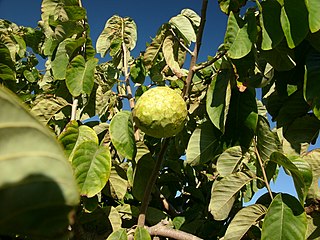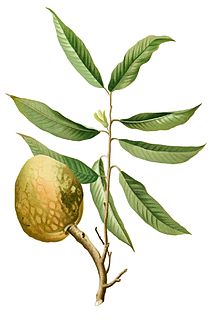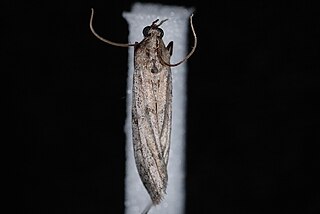
Asimina is a genus of small trees or shrubs described as a genus in 1763.

Soursop is the fruit of Annona muricata, a broadleaf, flowering, evergreen tree. The exact origin is unknown; it is native to the tropical regions of the Americas and the Caribbean and is widely propagated. It is in the same genus, Annona, as cherimoya and is in the Annonaceae family.

The sugar-apple, or sweetsop, is the fruit of Annona squamosa, the most widely grown species of Annona and a native of tropical climate in the Americas and West Indies. The Spanish traders of Manila galleons brought it to Asia.

The cherimoya, also spelled chirimoya and called chirimuya by the Inca people, is an edible fruit-bearing species of the genus Annona from the family Annonaceae. They were believed to be native to Colombia, Ecuador, Peru, Bolivia and Chile, spreading through cultivation to the Andes and Central America. But they have been found to have originated in Central America.

Annona is a genus of flowering plants in the pawpaw/sugar apple family, Annonaceae. It is the second largest genus in the family after Guatteria, containing approximately 166 species of mostly Neotropical and Afrotropical trees and shrubs. The generic name derives from anón, a Hispaniolan Taíno word for the fruit. Paleoethnobotanical studies have dated Annona exploitation and cultivation in the Yautepec River region of Medicoto approximately 1000 BC. It has several common names, including Guanabana, and Soursop.

Custard apple is a common name for a fruit, and the tree which bears it, Annona reticulata.

Annona reticulata is a small deciduous or semi-evergreen tree in the plant family Annonaceae and part of the Annonas group. It is best known for its fruit, called custard apple, a common name shared with fruits of several other species in the same genus: A. cherimola and A. squamosa. Its common names include wild sweetsop, soursop and bullock's heart. The fruit is sweet and useful in preparation of desserts, but is generally less popular for eating than that of A. cherimola.

Annona glabra is a tropical fruit tree in the family Annonaceae, in the same genus as the soursop and cherimoya. Common names include pond apple, alligator apple, swamp apple, corkwood, bobwood, and monkey apple. The tree is native to Florida in the United States, the Caribbean, Central and South America, and West Africa. It is common in the Everglades. The A. glabra tree is considered an invasive species in Sri Lanka and Australia. It grows in swamps, is tolerant of saltwater, and cannot grow in dry soil.

Annona montana, the mountain soursop, is an edible fruit in the Annonaceae family native to Central America, the Amazon, and islands in the Caribbean. It has fibrous fruits. A. montana may be used as a rootstock for cultivated Annonas.
Wild custard apple, and wild soursop may refer to at least two species of plant in the genus Annona:

Rollinia is a genus of plants in the family Annonaceae. While it is widely recognised as a distinct genus a recent monograph advocates its inclusion in Annona, which also contains custard apples and soursops.

Rollinia deliciosa is a species of flowering plant in the custard-apple family, Annonaceae, that is native to tropical South America. It is cultivated for its edible fruits, commonly known as biribá, lemon meringue pie fruit, or wild sugar-apple, throughout the world's tropics and subtropics.

Annona senegalensis, commonly known as African custard-apple, wild custard apple, wild soursop, sunkungo, and dorgot is a species of flowering plant in the custard apple family, Annonaceae. The specific epithet, senegalensis, translates to mean "of Senegal", the country where the type specimen was collected.
Epimetasia is a genus of moths of the family Crambidae.

Annona crassiflora, commonly known as marolo, araticum cortiça, araticum do cerrado or bruto, is a flowering plant in the Annonaceae family. The flowers of a marolo look like jellyfish wearing hats, and the fruits are sweet and very rough. It is native to Brazil and Paraguay and the fruit is eaten by native peoples in the Brazilian Cerrado. Although it is considered to have potential for cultivation, it has not been domesticated to date.
Anonaepestis is a genus of snout moths. It was erected by Émile Louis Ragonot in 1894.

Epischnia is a genus of moths of the family Pyralidae described by Jacob Hübner in 1825.
Ancylosis pectinatella is a species of snout moth in the genus Ancylosis. It was described by Joseph de Joannis in 1915 and is known from Mauritius.
Anonaepestis tamsi is a species of snout moth in the genus Anonaepestis. It was described by John David Bradley in 1965 and is known from Cameroon and the Central African Republic.

Vitula edmandsii, the American wax moth, dried-fruit moth or dried fruit moth, is a species of snout moth in the genus Vitula. It shares its common name with Cadra calidella, another dried fruit moth. It was described by Packard in 1865. It is found in Germany, Denmark and Fennoscandia, as well Great Britain and eastern North America. The beehive honey moth, which is found in western North America, is either treated as a full species or as a subspecies of Vitula edmandsii.













